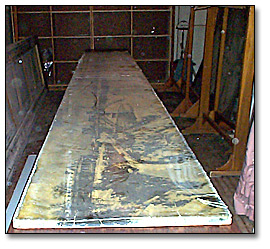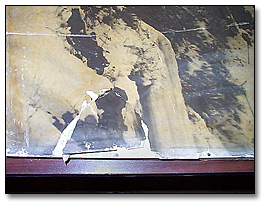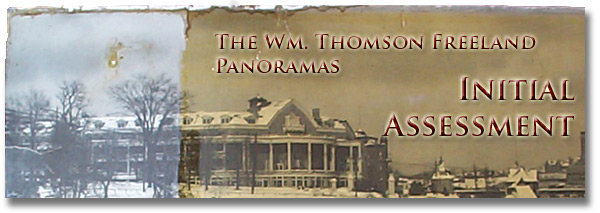
To establish a temporary working area, a
Queen's Park storage room that normally held Christmas decorations
and unused drapes was converted to a temporary conservation
lab. Here, a long table was assembled to support the photographs
one at a time. The winter panorama was assessed and treated first. Information on materials and processes that we derived from examining the winter panorama could be applied to the summer photograph.
However, damages to the summer print substrate and frame were less extensive. This is likely due to the fact that when they were discovered the summer panorama was underneath the winter panorama and partially protected. Assessment of the winter panorama is detailed below.
Now that the photographs were in a more hospitable environment an initial inspection noted any general concerns and problems. An action plan was drawn up and treatment began.
The first photo to be examined was the winter scene. The first step was to remove it from its frame, for possibly the first time in over 90 years.
Initial Assessment of the Winter Panorama
The varnished areas of the panorama exhibited
a warm, yellowish tone and a limited tonal range. Unvarnished
areas along the edges outside the frame window were cool
and greyish and had greater tonal range. Beyond discolouration there was
a significant amount of physical damage.
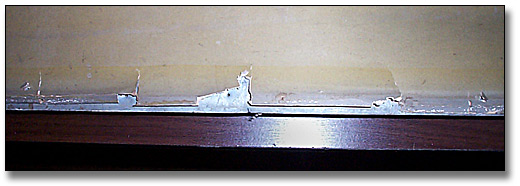
Detail showing typical damage along the edge of the photograph, especially around
the nails through the print, the metal the photo is adhered to ("its backing") and the
wooden stretcher support.
Following the visual examination, solubility tests were performed with water and alcohol in an unvarnished area along the edge of the panorama to determine the photographic print type. These results, combined with the age of the photographs and discussions with other conservators, supported the identification of the Freeland Panoramas as silver gelatin prints.
Photographic Prints
A photograph is a still image made visible by the action of light on a light-sensitive material/compound. Photographs are usually composed of a support (such as paper, metal, glass or plastic) that is coated with an image-bearing layer (the emulsion).
Identification of the panorama’s photographic print process was done with non-destructive tests and in consultation with other conservators. The Freeland panoramas appear to be very degraded black and white silver gelatin prints.
Silver Gelatin Prints
Silver gelatin prints are composed of light-sensitive silver chloride salts suspended in a gelatin binder. Many silver gelatin prints also have an interlayer between the image bearing layer (the emulsion) and the support that is called the baryta layer. The support is paper.
Black and white prints are most susceptible to damage from high relative humidity and oxidizing chemicals. Gelatin emulsions are also prone to mould growth in higher relative humidity.
The William Thomson Freeland Panorama Photographs
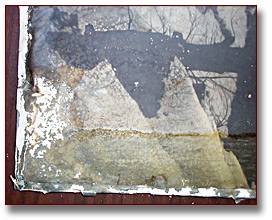
The layers of the Freeland Panoramas:
- Emulsion - Image-bearing layer composed of light-sensitive silver chloride salts suspended in a gelatin binder
- Baryta - A very white, chalky layer added to increase the optical brightness of the print
- Paper Support - In this case a thin and brittle paper, likely made of wood pulp
Print Damage
There was significant physical damage to
both prints. Paper and emulsion losses were concentrated along the edges, likely due to handling and abrasion from the frame. The photos were detached from the metal backing wherever there were tears, which were often associated with nails, water damage/tidelines and image loss.
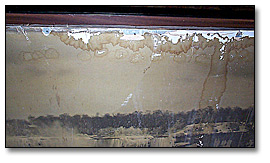
Detail showing tidelines and image loss due
to water damage and possibly partly from
the application of varnish.
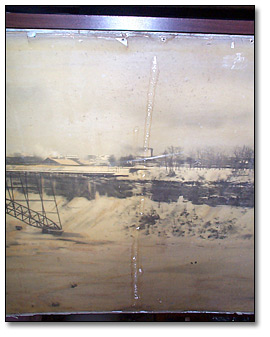
There were several stains or tidelines, amber to brownish in colour, and the images had an overall yellowish cast due to the varnish. Some areas had a reddish tone with small pinkish accretions.
loss in the image area likely due to water.
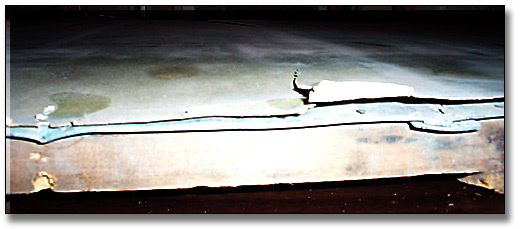
A cross sectional view showing the silver gelatin print at the top, lifted and torn away from
the edge of the metal backing. Nails are also visible which pierced the print,
metal backing, and supporting wooden strainer.
Discovery | Initial Assessment | Removing the Varnish | Repairs
The Move | The Summer Panorama | The Winter Panorama
